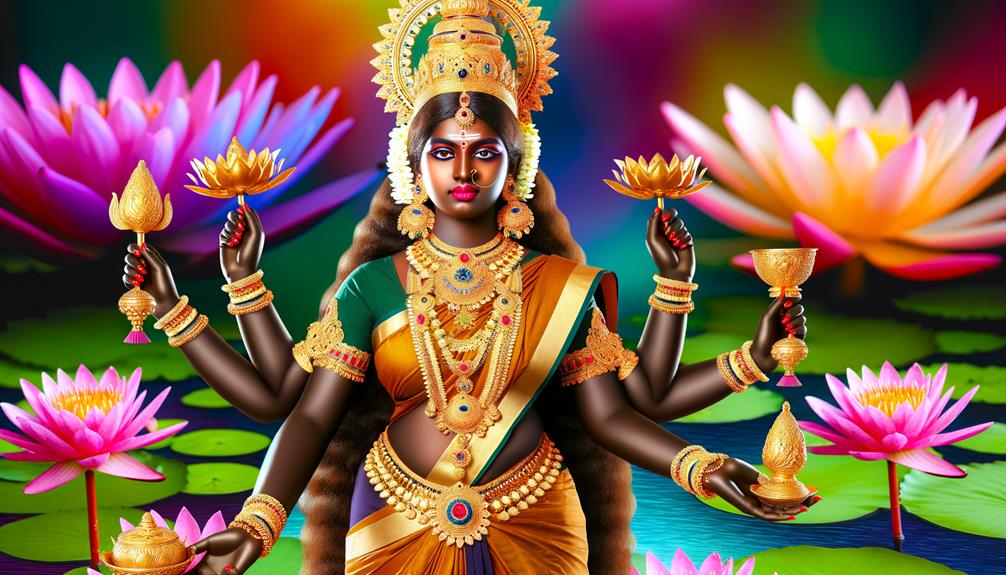Meaning of the Name Kali
The name 'Kali' stems from ancient Sanskrit, denoting 'time' and 'the black one.' Emerging from the word 'kāla,' it signifies the inexorable passage of time and primordial darkness. In Hindu mythology, Kali symbolizes both destruction and creation, epitomizing the cyclical nature of existence.
As a fierce deity born from Durga's forehead, her iconography includes elements of mortality and rebirth, challenging traditional views on gender roles. Revered for her duality, Kali embodies protection, transformation, and empowerment.
The multifaceted nature of her name offers a profound insight into her complex character and enduring cultural impact. Explore further to understand this enigmatic deity.

Key Takeaways
- The name Kali originates from the ancient Sanskrit word 'kāla,' meaning 'time' or 'black.'
- Kali symbolizes the cycle of creation and destruction, reflecting the cyclical nature of time.
- As a Hindu goddess, Kali embodies both fearsome and nurturing aspects, representing life and death.
- The name Kali signifies empowerment, transformation, and the destruction of ignorance.
- Kali's multifaceted nature challenges traditional gender roles and emphasizes the divine feminine's fierce aspect.
Etymology and Origins
Rooted in the ancient Sanskrit language, the name 'Kali' derives from the word 'kāla,' which signifies both 'time' and 'black' in its varying contexts.
The etymological origins of 'Kali' emphasize a duality that is foundational to understanding the term. Historically, 'kāla' has been used to denote the inexorable passage of time, a force that neither man nor deity can escape.
Simultaneously, 'kāla' also represents the color black, symbolizing the void or the primordial darkness before creation. This dual significance encapsulates the essence of Kali as a figure who transcends and embodies both time and the cosmic void.
The name intricately links Kali to concepts of temporality and primordial chaos, reflecting deep philosophical undertones.
Hindu Mythological Significance
In Hindu mythology, Kali is revered as a formidable goddess who embodies both destruction and transformation, playing a pivotal role in the cosmic cycle of creation and dissolution. Emerging from the forehead of Goddess Durga during a fierce battle, Kali's form is both awe-inspiring and terrifying. Her iconography, featuring a garland of skulls and a skirt of severed arms, underscores her dominion over life and death.
| Aspect | Description |
|---|---|
| Origin | Emerged from Durga's forehead |
| Iconography | Garland of skulls, skirt of severed arms |
| Symbolism | Represents the cycle of creation, preservation, destruction |
Kali is not merely a deity of violence but also a powerful force of change, purging negativity and ushering in renewal. Her worship involves both fear and reverence, encapsulating the duality of nature itself.
Symbolism in Religion
In religious symbolism, Kali epitomizes the Hindu goddess of destruction and rebirth, embodying both fearsome and nurturing aspects of the divine feminine power.
Historically, she has been revered for her duality, representing life and death, creation and annihilation.
This symbolic duality offers a profound understanding of the cyclical nature of existence within Hindu philosophy.
Hindu Goddess Representation
Representing both destruction and renewal, the Hindu goddess Kali embodies profound symbolic significance within the pantheon of Hindu deities. Historically, Kali is depicted as a fierce, dark-skinned figure adorned with a garland of skulls, symbolizing the cycle of life, death, and rebirth.
Her outstretched tongue and multiple arms holding various weapons signify her role in the eradication of evil and ignorance. Kali's iconography, rooted in ancient texts such as the Devi Mahatmya, underscores her dual nature as both a destroyer of demonic forces and a motherly figure who offers protection and liberation.
This complex representation highlights the interconnectedness of creation and destruction, reflecting the cyclical nature of the universe in Hindu cosmology.
Divine Feminine Power
Throughout various religious traditions, the concept of divine feminine power serves as a profound symbol of creation, nurturing, and transformative energy. In Hinduism, Kali epitomizes this power through her roles as creator, preserver, and destroyer. Her fierce aspect symbolizes the transformative forces necessary for cosmic balance. Similarly, other cultures embrace divine feminine archetypes that embody these qualities.
| Religion | Divine Feminine Archetype |
|---|---|
| Hinduism | Kali |
| Ancient Egypt | Isis |
| Greek Mythology | Gaia |
Historically, these divine figures have been invoked for their abilities to bring life, sustain it, and transform it through destruction and renewal. In each tradition, the divine feminine serves as a pivotal force, essential for maintaining the equilibrium of the universe and humanity's spiritual evolution.
Symbolic Duality Explained
Symbolic duality in religious narratives often serves to convey complex truths about the human condition and the universe. In Hinduism, the goddess Kali embodies this duality. Representing both creation and destruction, she is a fierce warrior against evil but also a nurturing mother.
Historically, Kali's iconography—severed heads and a garland of skulls—symbolizes the annihilation of the ego and the cycle of life and death. Her dark skin represents the eternal darkness from which everything emerges and into which everything dissolves.
This duality highlights the interconnectedness of seemingly opposite forces, reflecting the belief that life's paradoxes are essential for spiritual growth. By understanding Kali, one gains insight into the profound balance between life's creative and destructive energies.
Cultural Impact
The name Kali has permeated contemporary culture, manifesting in various forms of popular media from literature to cinema, often symbolizing power and transformation.
This cultural representation extends beyond entertainment, influencing modern spirituality where Kali's attributes are embraced in personal growth and empowerment practices.
Analyzing these trends reveals the enduring and evolving significance of Kali in both historical and modern contexts.
Influence in Popular Media
In contemporary popular media, the name Kali has garnered significant attention, often being portrayed in films, television series, and literature, reflecting both its historical roots and evolving cultural significance.
Frequently depicted as a fierce goddess embodying destruction and transformation, Kali captures the imagination of creators and audiences alike. For instance, the character has appeared in Western media such as Indiana Jones and the Temple of Doom, where her portrayal, though controversial, underscores her potent mythological influence.
Additionally, in literature, she is often symbolized as a force of empowerment and resilience, resonating with modern themes of female strength. These portrayals, while diverse, continue to shape and perpetuate Kali's complex legacy within the global cultural consciousness.
Role in Modern Spirituality
Beyond her depictions in popular media, Kali's significance extends deeply into modern spirituality, where she is revered as a symbol of transformative power and liberation. Her presence in contemporary spiritual practices underscores a profound impact on personal and collective consciousness.
Kali serves as:
- Catalyst for Inner Transformation: Embracing Kali encourages individuals to confront and transcend their fears.
- Embodiment of Feminine Power: She represents the potent energies of the divine feminine, inspiring empowerment and resilience.
- Spiritual Liberation: Kali's iconography and mythology emphasize the destruction of ego, leading to spiritual awakening.
- Cultural Bridge: In a globalized world, Kali's image bridges Eastern and Western spiritual traditions, fostering cross-cultural understanding.
Her role in modern spirituality reflects a dynamic interplay between ancient wisdom and contemporary spiritual needs.
Modern Interpretations
Modern interpretations of the name Kali often reflect a blend of historical reverence and contemporary cultural significance. Historically, Kali is venerated as a powerful Hindu goddess embodying both destruction and rebirth.
Today, this duality is recontextualized within modern frameworks, encompassing themes of transformation and protection. Kali's iconography—her fierce visage and numerous arms wielding weapons—has been adopted in popular culture, symbolizing resilience and defiance against oppression.
Moreover, contemporary spiritual movements appreciate Kali as an archetype of divine feminine power, integrating her attributes into diverse practices. This multifaceted representation underscores her enduring impact, bridging ancient traditions with modern sensibilities, and illustrating a dynamic evolution in the understanding of her name and essence.
Empowerment and Strength
Revered for her formidable strength and transformative power, Kali's name has come to symbolize profound empowerment, especially within the context of personal and societal resilience. Historically, Kali is depicted as a fierce goddess who embodies the destruction of evil and the triumph of justice. This symbolism translates into modern interpretations of empowerment, illustrating the ability to overcome adversity and initiate change.
Key aspects of Kali's empowerment include:
- Destruction of Ignorance: Kali represents the eradication of ignorance, leading to enlightenment.
- Transformation: She embodies the transformative process necessary for growth and renewal.
- Protection: Kali serves as a protector of the oppressed and marginalized.
- Fearlessness: Her fearless nature inspires individuals to confront their deepest fears.
Thus, Kali's essence empowers individuals and communities alike.
Conclusion
In summation, the name Kali encompasses a rich tapestry of meanings that traverse etymological, mythological, religious, and cultural dimensions.
From its roots in ancient Hindu texts to its modern interpretations, Kali symbolizes both destruction and empowerment, akin to the dual nature of Janus in Roman mythology.
This multifaceted goddess continues to inspire and evoke reverence, embodying strength and resilience in a world that constantly seeks to understand the divine and the mortal.






